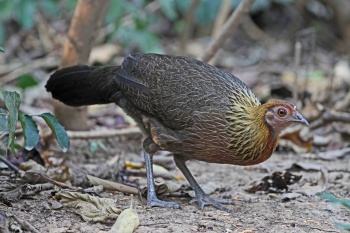Aloktewari (talk | contribs) (copyright symbol to images) |
|||
| (4 intermediate revisions by 2 users not shown) | |||
| Line 1: | Line 1: | ||
| + | [[Image:red_junglefowl_alok.JPG|thumb|550px|right|Male : Subspecies ''G. g. murghi''<br />Photo © by {{user|aloktewari|Alok Tewari}} <br />Pilibhit Tiger Reserve, Uttar Pradesh, [[India]], January-2015]] | ||
;[[:Category:Gallus|Gallus]] gallus | ;[[:Category:Gallus|Gallus]] gallus | ||
| − | + | ||
==Identification== | ==Identification== | ||
| − | + | Male 65–78 cm ; female 41–46 cm<br /> | |
| − | Male | + | '''Male''' |
| − | + | *Red comb | |
| − | + | *Whitish 'eat' patch | |
| + | *Neck area covered in yellow and bronze feathers<br /> | ||
| + | '''Female''' has more cryptic plumage for camouflage | ||
| + | [[Image:Red_Junglefowl.jpg|thumb|350px|right|Male : Subspecies ''G. g. spadiceus''<br />Photo © by {{user|Joe+Pan|Joe Pan}} <br />Lahad Datu, Sabah, [[Malaysia]], November 2005]] | ||
==Distribution== | ==Distribution== | ||
Northeast [[India]] eastwards across southern [[China]] and down into [[Malaysia]], [[Indonesia]], and the [[Philippines]]. | Northeast [[India]] eastwards across southern [[China]] and down into [[Malaysia]], [[Indonesia]], and the [[Philippines]]. | ||
| + | |||
| + | [[Borneo]] is not in their natural range but they were introduced into oil palm plantations of Eastern Sabah. They have since become firmly established and big flocks of them can be commonly seen in plantations in the Lahad Datu,Kinabatangan and other neighbouring districts. | ||
| + | |||
| + | They have also been introduced to [[Hawaii]] | ||
==Taxonomy== | ==Taxonomy== | ||
| + | [[Image:855 sm filtered.jpg|thumb|350px|right|Female : Nominate subspecies<br />Photo © by {{user|martinuk|martinuk}}<br />Bahn Song Nok, Phetchaburi Province, [[Thailand]], February 2012]] | ||
====Subspecies==== | ====Subspecies==== | ||
| − | *''G. g. murghi'' - | + | There are 5 subspecies<sup>[[#References|[1]]]</sup>: |
| − | *''G. g. spadiceus'' - Myanmar to | + | *''G. g. murghi'' - Northern [[India]] and adjacent [[Nepal]] and [[Bangladesh]] |
| − | *''G. g. jabouillei'' - | + | *''G. g. spadiceus'' - [[Myanmar]] to south-western Yunnan, [[Malay Peninsula]] and northern [[Sumatra]] |
| − | *''G. g. gallus'' - | + | *''G. g. jabouillei'' - Northern [[Vietnam]] to southern [[China]] (south-eastern Yunnan, Guangxi and Hainan Island) |
| − | *''G. g. bankiva'' - | + | *''G. g. gallus'' - Northern [[Indochina]] to eastern [[Thailand]] |
| + | *''G. g. bankiva'' - Southern Sumatra, [[Java]] and [[Bali]] | ||
==Habitat== | ==Habitat== | ||
| + | Tropical lowland forests, secondary, disturbed, evergreen and deciduous forests and forest edges; open grasslands, scrub, jungle, mangroves, orchards and plantations. | ||
==Behaviour== | ==Behaviour== | ||
| − | + | They can fly much better than domesticated chickens. | |
| + | ====Diet==== | ||
| + | They are [[Dictionary_M-O#O|Omnivorous]] and will eat whatever they happen upon. | ||
| + | ====Vocalisation==== | ||
| + | '''Call''': Typical ''cock-a-doodle-doo'' call. | ||
| + | ==References== | ||
| + | #{{Ref-Clements6thAug15}}#Handbook of the Birds of the World Alive (retrieved June 2016) | ||
| + | #BF Member observations | ||
| + | {{ref}} | ||
==External Links== | ==External Links== | ||
| − | {{GSearch| | + | {{GSearch|Gallus_gallus}} |
| − | [[Category:Birds]] [[Category:Gallus]] | + | <br /> |
| + | {{Video|Red_Junglefowl}} | ||
| + | |||
| + | [[Category:Birds]] [[Category:Gallus]] [[Category:Videos]] | ||
Revision as of 10:00, 16 May 2019

Photo © by Alok Tewari
Pilibhit Tiger Reserve, Uttar Pradesh, India, January-2015
- Gallus gallus
Identification
Male 65–78 cm ; female 41–46 cm
Male
- Red comb
- Whitish 'eat' patch
- Neck area covered in yellow and bronze feathers
Female has more cryptic plumage for camouflage
Distribution
Northeast India eastwards across southern China and down into Malaysia, Indonesia, and the Philippines.
Borneo is not in their natural range but they were introduced into oil palm plantations of Eastern Sabah. They have since become firmly established and big flocks of them can be commonly seen in plantations in the Lahad Datu,Kinabatangan and other neighbouring districts.
They have also been introduced to Hawaii
Taxonomy
Subspecies
There are 5 subspecies[1]:
- G. g. murghi - Northern India and adjacent Nepal and Bangladesh
- G. g. spadiceus - Myanmar to south-western Yunnan, Malay Peninsula and northern Sumatra
- G. g. jabouillei - Northern Vietnam to southern China (south-eastern Yunnan, Guangxi and Hainan Island)
- G. g. gallus - Northern Indochina to eastern Thailand
- G. g. bankiva - Southern Sumatra, Java and Bali
Habitat
Tropical lowland forests, secondary, disturbed, evergreen and deciduous forests and forest edges; open grasslands, scrub, jungle, mangroves, orchards and plantations.
Behaviour
They can fly much better than domesticated chickens.
Diet
They are Omnivorous and will eat whatever they happen upon.
Vocalisation
Call: Typical cock-a-doodle-doo call.
References
- Clements, J. F., T. S. Schulenberg, M. J. Iliff, D. Roberson, T. A. Fredericks, B. L. Sullivan, and C. L. Wood. 2015. The eBird/Clements checklist of birds of the world: v2015, with updates to August 2015. Downloaded from http://www.birds.cornell.edu/clementschecklist/download/
- Handbook of the Birds of the World Alive (retrieved June 2016)
- BF Member observations
Recommended Citation
- BirdForum Opus contributors. (2024) Red Junglefowl. In: BirdForum, the forum for wild birds and birding. Retrieved 19 April 2024 from https://www.birdforum.net/opus/Red_Junglefowl
External Links





